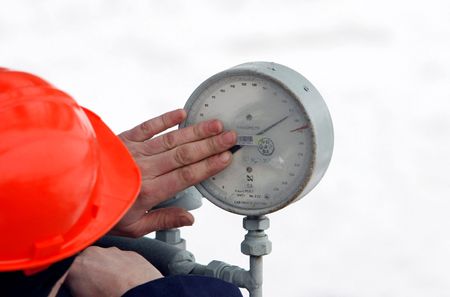
By Nina Chestney
LONDON (Reuters) – If Moscow carries out a threat to sanction Ukrainian energy firm Naftogaz one of the last functioning Russian gas supply routes to Europe could be shut, exacerbating the energy crisis just as the crucial winter heating season begins.
Naftogaz initiated a new arbitration proceeding against Gazprom earlier this month, saying the Russian company has not paid transit fees for sending its gas to Europe via pipelines that cross Ukraine.
Gazprom this week rejected all the claims, adding that Russia may introduce sanctions against Naftogaz in the case that it further pursues the matter. Such sanctions would prohibit Gazprom from paying Ukraine transit fees, which analysts say could end Russian gas flows to Europe via the country.
Yuriy Vitrenko, chief executive of Naftogaz, says the company will continue with arbitration proceedings against Gazprom regardless.
“(Sanctions) would make into reality the worst-case scenario that European governments have been preparing for all summer, a European gas market without Russian gas,” said Natasha Fielding, head of EMEA gas pricing at Argus Media.
“Transit through Ukraine is the only Russian gas delivery route to Europe still in use besides the Turkish Stream pipeline, which serves southeast European countries,” she added.
Dutch wholesale gas prices, the European benchmark, shot up after Gazprom’s talk of sanctions on Tuesday, and rallied as much as 13% on Wednesday to stand around 120% higher since the start of the year.
Gas flows via the only operational Ukraine transit route through Sudzha are currently around 42 million cubic metres a day. Kyiv had already in May suspended the Sokhranivka route which delivered almost a third of the fuel piped from Russia to Europe through Ukraine, declaring force majeure.
Leaks detected on the Nord Stream 1 pipeline this week make a resumption of flows on that route unlikely after they were cut to a fraction of capacity and finally suspended last month with Moscow citing the need for maintenance.
Meanwhile the Yamal-Europe pipeline has been flowing eastbound from Germany to Poland for much of this year, although it has been in stop-start mode for weeks.
WINTER RISK
Should the Sudzha flows come to a halt, the only Russian gas being piped to Europe would be via Turkey and the Black Sea through TurkStream, which has an annual capacity of around 31.5 billion cubic metres.
Gazprom ramped up supply to Hungary via the pipeline in August but overall Europe has been preparing for months for a complete stoppage of Russian gas deliveries this winter.
Governments have been scrambling to diversify supply, buying more liquefied natural gas from suppliers such as the United States, Qatar and Egypt, as well as introducing measures to curb demand domestically and save energy.
As a result, European gas storage was 88% full as of Sept. 26, although there are variations between countries.
“There needs to be a combination of ‘ifs’ to threaten Europe’s energy supplies this winter, including a harsh winter, prolonged French nuclear outages, and other infrastructure issues,” said Norbert Rücker, head of economics and next generation research at investment bank Julius Baer.
However, a greater risk remains for next winter as countries will end this year’s winter gas season with very low stocks and have less Russian pipeline gas available than ever before to replenish stocks during the spring and summer.
(Reporting by Nina Chestney; editing by Pratima Desai and Kirsten Donovan)

